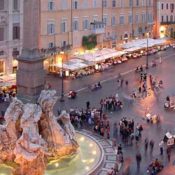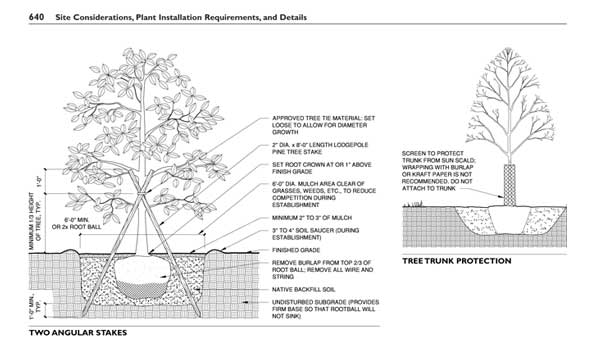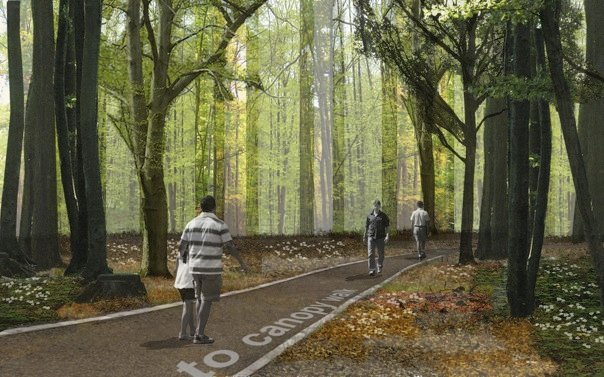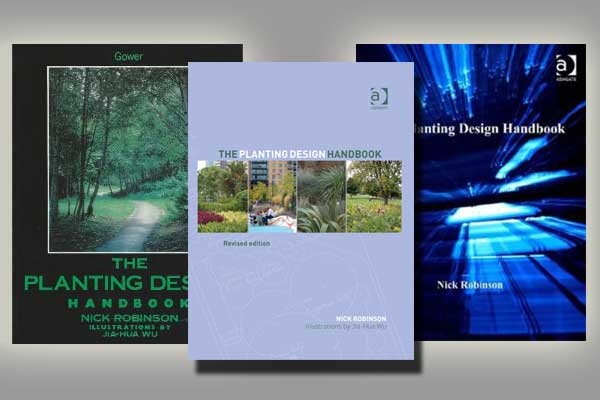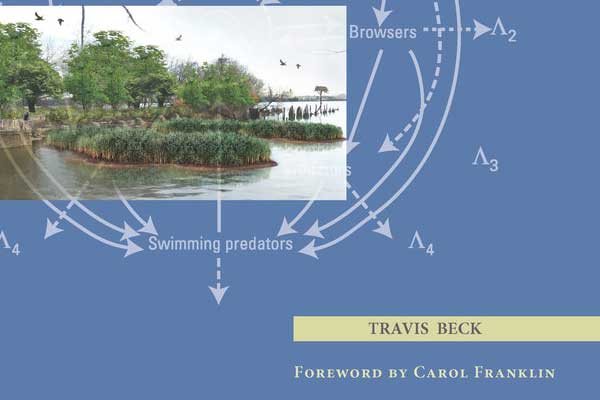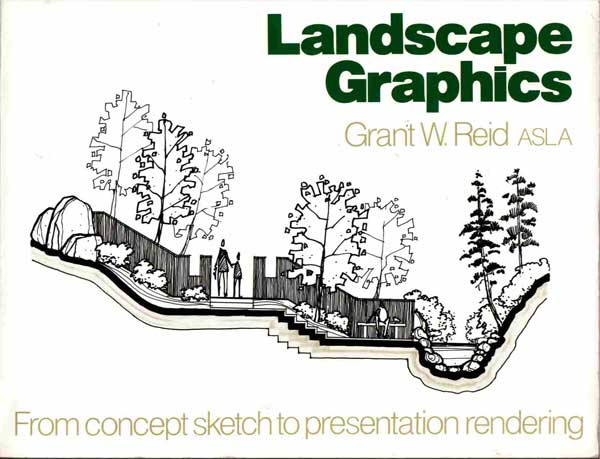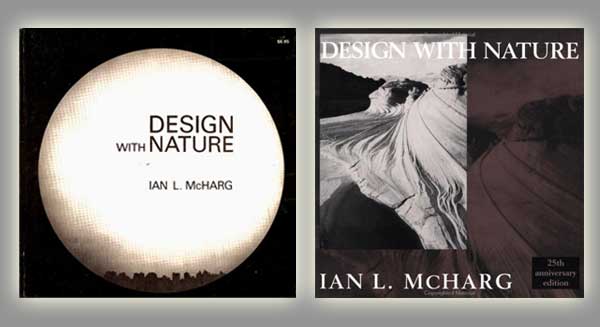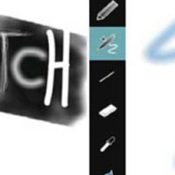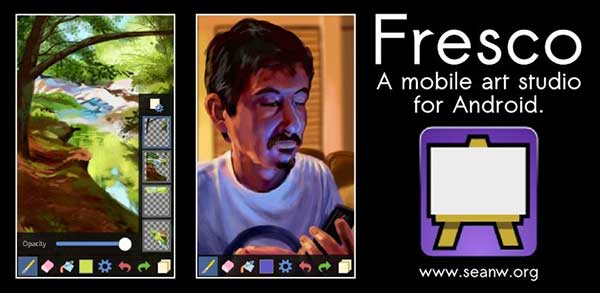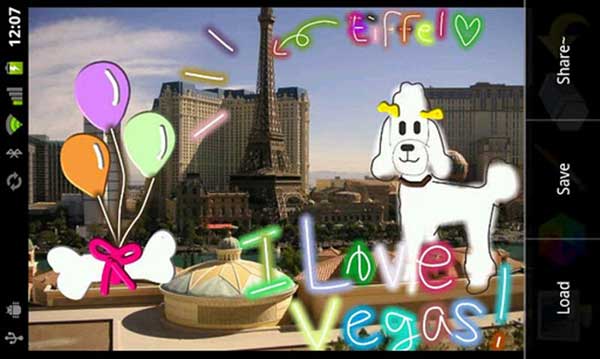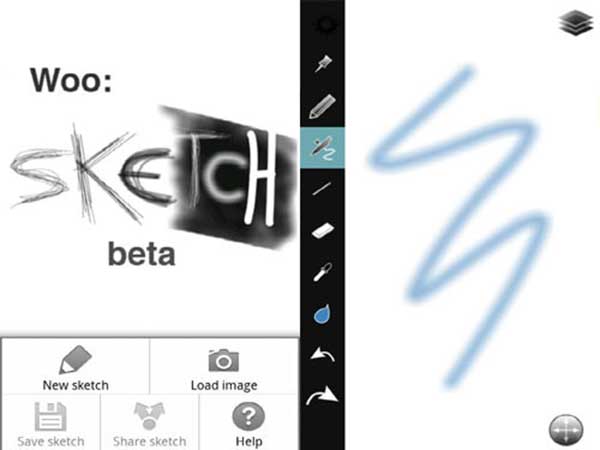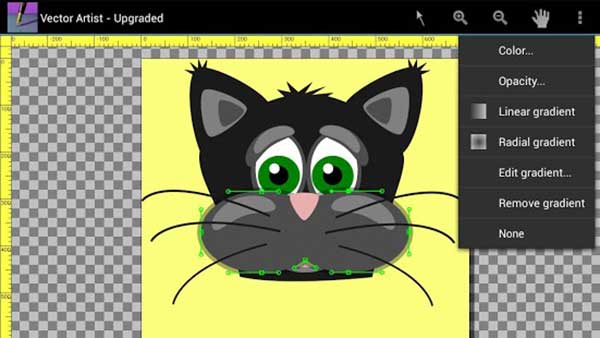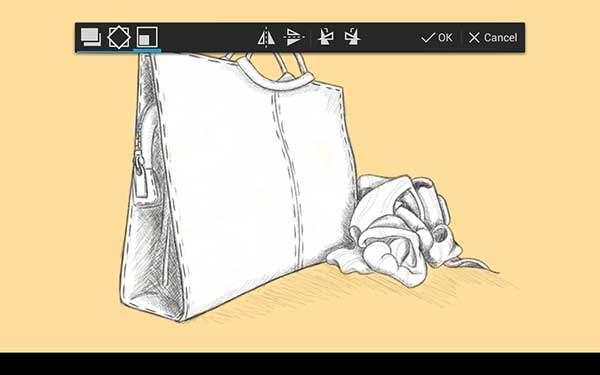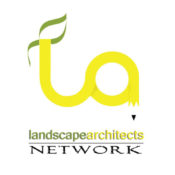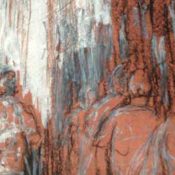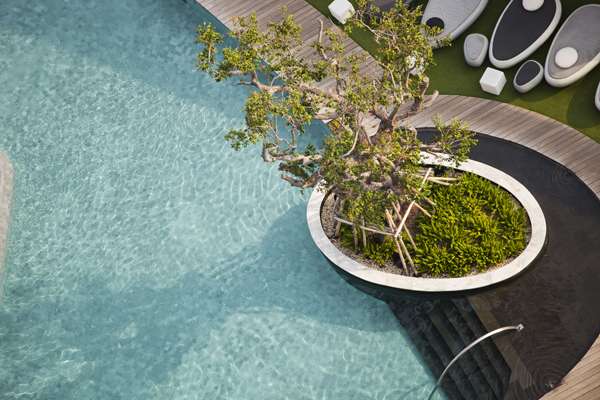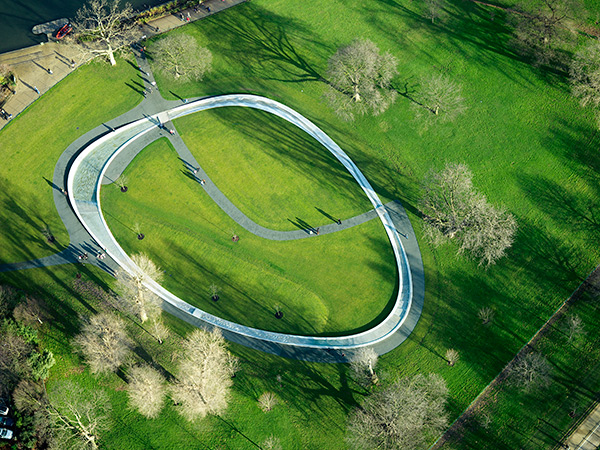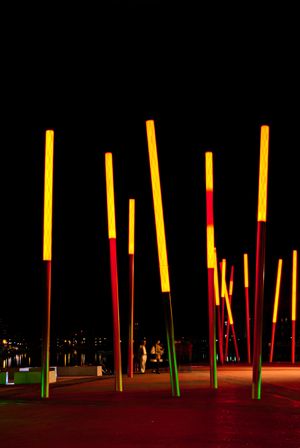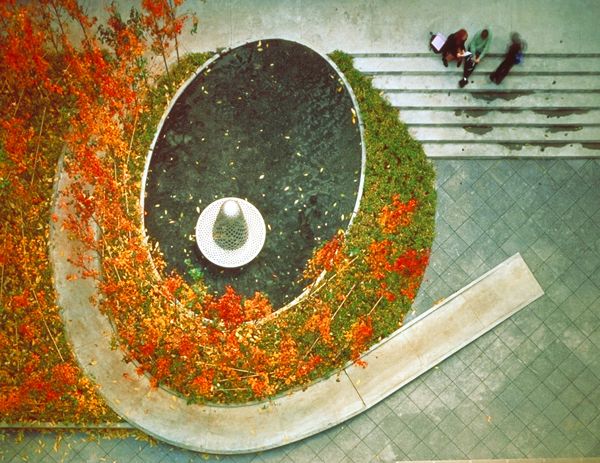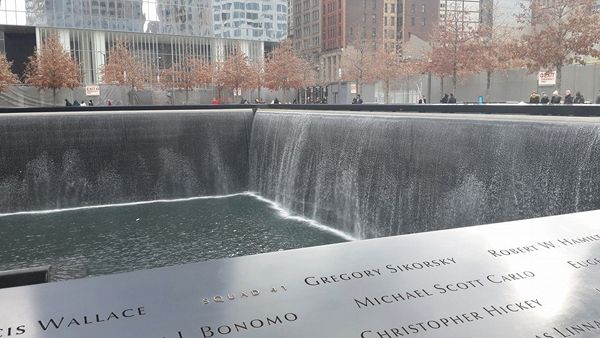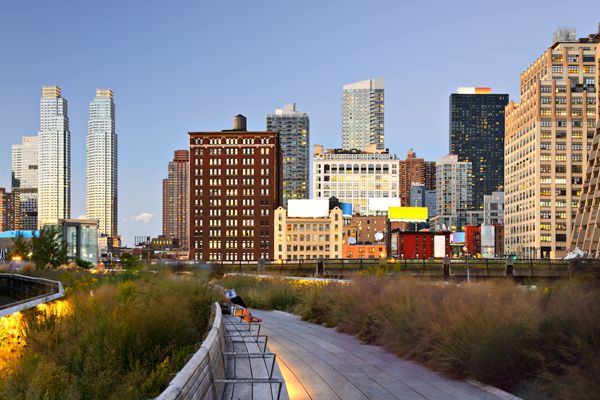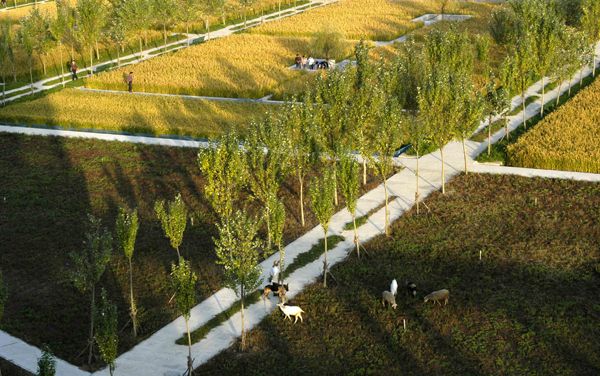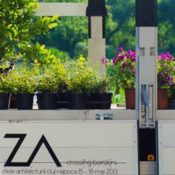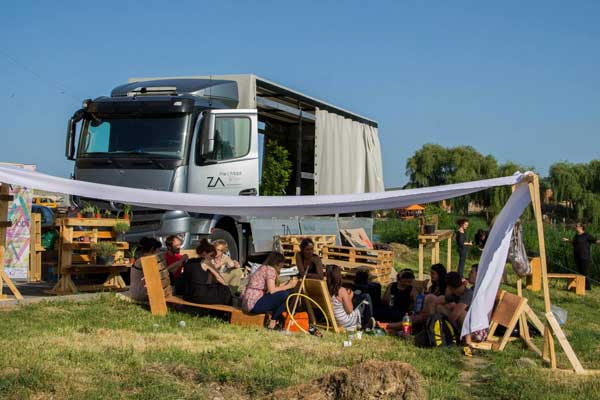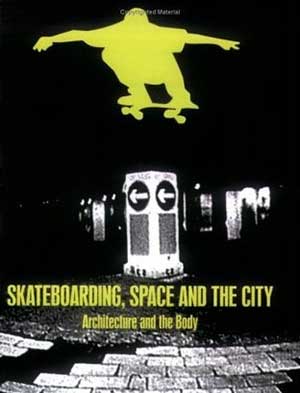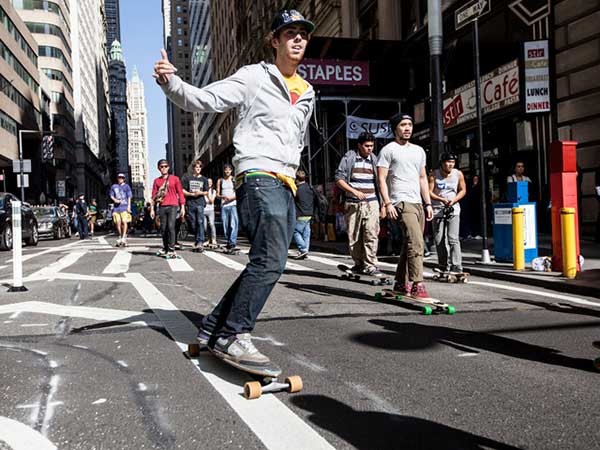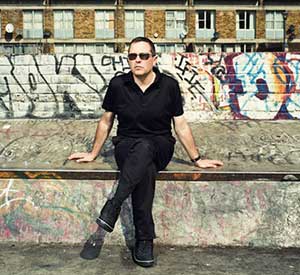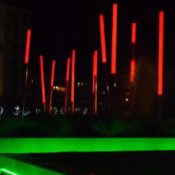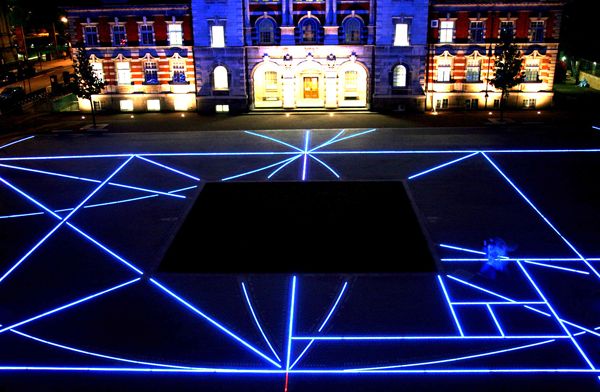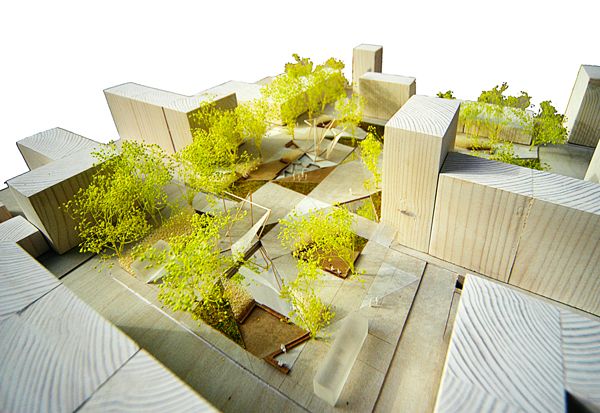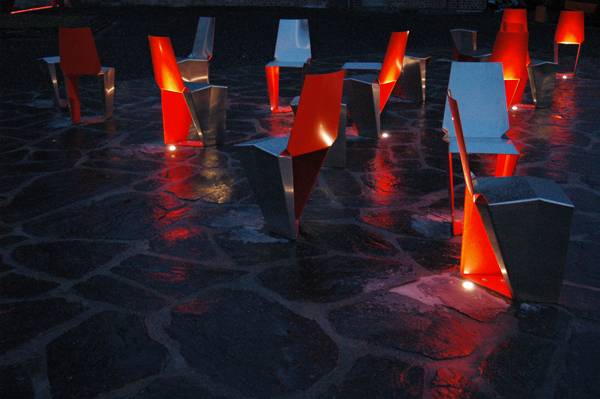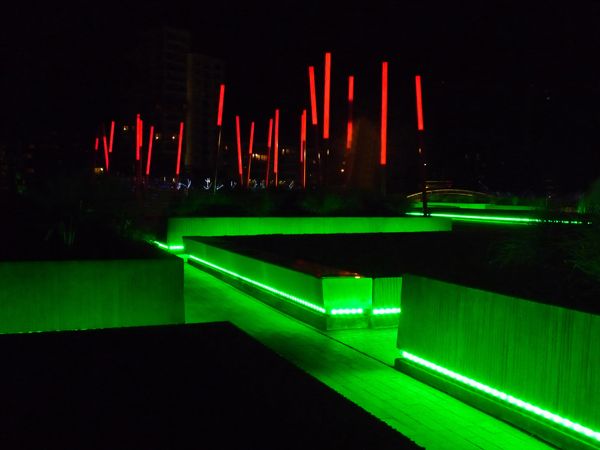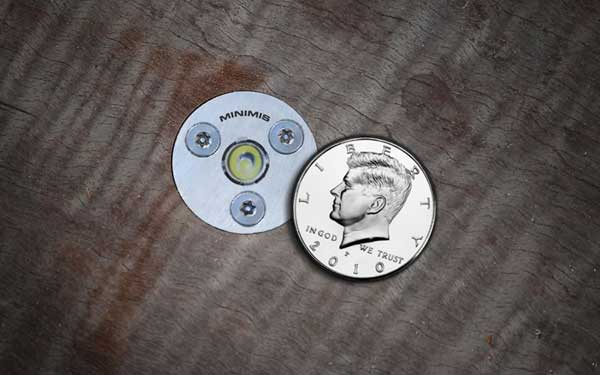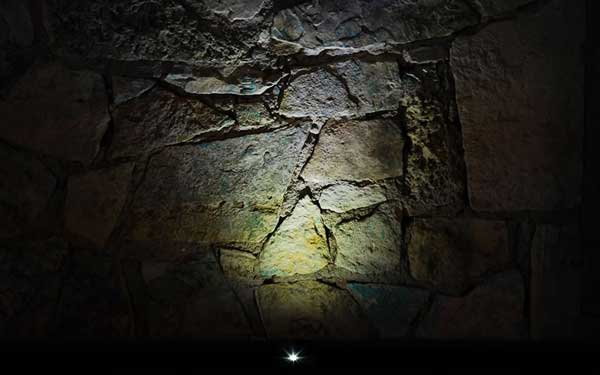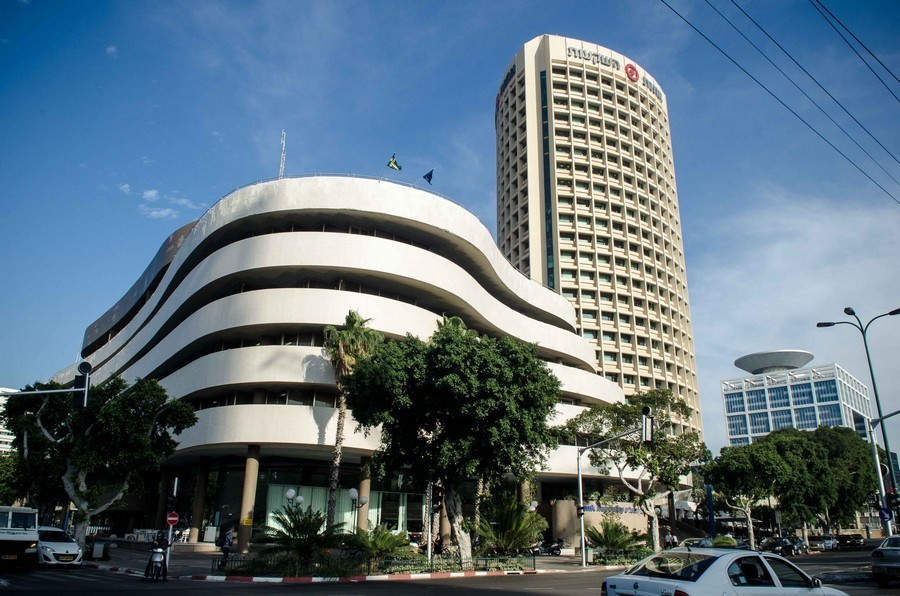Author: Land8: Landscape Architects Network
Sketchy Saturday– No. 005
We are back with another selection of ten amazing drawings created by our talented readers and carefully chosen by our team. Sit back and enjoy the stunning work by true artists – by graduates as well as students of landscape architecture. And if you feel that our selection is lacking, why not send us your own piece? We are constantly looking for beautiful drawings, inspirational sketches and stylish illustrations!
10. By Merima Pernjak, BA Landscape Architect, from Cyprus
“I graduated in Landscape Architecture two years ago. I work on residential and commercial projects all over the beautiful island of Cyprus. I found out during my drawing lessons just how much I enjoy to draw and that I have a little talent, just waiting to be explored. This drawing was created during my second year at university. In this lesson we focused on perspective drawing as well as the depiction of depth and shadows using only pencils.”
9. By Vincent Lemay, Landscape architect
”For the past 13 years, The Montreal International Mosaicultures Exhibition has been promoting landscape architecture projects from around the world. This year, I drew a sketch for the City of Montreal where I currently work as a landscape architect. The garden, located within the Montreal Botanical Gardens, brings together 25,000 plants and the sketch shows a pedestrian walkway under the city’s skyline. The final version of the sketch and full description of the project is displayed on site.” 8. By Jessie Hong“Kenroku-en is located in the Kanazawa, Japan, one of the three great gardens of Japan. Built between 1620s-1840s, this garden contains the oldest fountain in Japan, which is operating by natural water pressure. In winter, the ropes attached in a conical array work as a huge umbrella to protect the old pine trees from heavy snow.”
7. By Djordje Pralica from Serbia
“In my free time, I like to take long walks in urban areas of Belgrade and draw scenes which are special at that particular moment. The aim was to catch the right moment before sunset. The scene represents one of the most visited places in the Kalemegdan Fortress in Belgrade. The place located in the sketch is near the confluence of the rivers Sava and Danube. In the background there is a view of New Belgrade’s parks and architecture as two inseparable elements.”
6. By Kinga Piskorska
“It is a pencil sketch I made before the entrance exam in hand drawing for the Cracow University of Technology. The task during the ELIPSA Course of Drawing was to create a composition of a tree and a shrub from imagination, paying attention to aerial perspective, shades and contrasts. The picture shows traditional Polish landscape, famous for its disorderly, wild beauty. Polish countryside always strikes me with the variety of both plants and landforms.”
5. By Tyler Hannah – Graduated from Colorado State University in Landscape Architecture
“Tiger Bark Fig Bonsai drawn with pencil. The bonsai located inside the Denver Botanic Gardens, intrigued me with its textures and forms, and is a key piece of a larger and successful landscape dynamic.”
4. By Jana Sebova
“The sketch shows a new bridge across a small pond with even smaller islet in the Arboretum, Liptovsky Hradok, Slovakia. The arboretum was well known in the past. There was life there, even on this small islet, where intimate concerts were held. In my Diploma work I tried to reinstate its former glory and bring life to this glamorous piece of nature in the city centre.”
3. By Morozova Lada, landscape architect from Moscow
“Even a small residence needs a private and comfortable space for rest. How can one manage this, when the windows of neighbors are so close? Just make an arch with pergolas at the centre, surround this patio with the smell of flowers and enjoy the result!”
2. By Wiktor Kłyk, landscape architect
”Simple stream until today, closed by the framework of concrete walls. Calm waters visually acquire power, cross the borders, sculpting power lines in an open landscape with freely scattered black alders and low-growing species of willows.”
1. By Devin Kimmel
“This is a drawing of a proposed house and garden. It was inspired by French country houses. The sketch is graphite on vellum.”
We hope you enjoyed today’s Top Ten drawings. We continue to be amazed by their high quality, variety of different techniques and the abilities of the artists! Keep up the good work and keep those beautiful sketches coming!
Article written by Marta Ratajszczak.
Enjoy what you’ve read! Support us and pick up one of our awesome T-shirts and hoodies today, Click the link
Top 10 Books For Landscape Architecture
The simple art of reading literature – one of the most beneficial ways of procuring knowledge — is one that is fast disappearing. Books mentally stimulate the creative part of your brain by allowing you to form an image of the words inside your head, while also giving you a unique pause button for understanding and insight. Stress reduction, vocabulary expansion, and improved writing skills are yet more perks from interpretation of the written word. With that in mind, I present the top 10 books for landscape architecture. 10. Lexicon of Garden and Landscape Architecture – by Meto J. Vroom An alphabetically arranged list of more than 250 garden and landscape architecture terms, concepts, and objects, each complete with definitions, critical commentary, and recommendations for further reading. Its compact size makes it an ideal portable resource for students unfamiliar with certain terms or who simply want to expand their vocabulary. Get it Here!
Lexicon of Garden and Landscape Architecture – available in two awesome bright colours so you’ll never lose it!
The traditional book lover may be a dying breed, but there’s no doubt that exposing oneself to a diverse range of books and absorbing their information with understanding is an infallible way to become an authority on a subject. The richness reading provides is unparalleled; I hope these 10 books offer just that.
Still cant’s make your mind up what to get, check out our LAN Associates Store! Article by Paul McAtomney Return to Homepage Featured image: License: CC0 Public Domain, source.
10 Most Interesting Free Android Drawing Apps
With thousands of Android drawing apps out there, it is easy to get confused and frustrated while wasting your time installing them just to try them out. To help you save your nerves, time, and space on your tablet, we chose the 10 most interesting free drawing apps, played with each a bit, and wrote down our impressions. The apps were tested on a Samsung Galaxy Note 10.1 tablet, running on Android 4.1.2 Jelly Bean. We decided to check out a variety of apps — best for sketching, painting, vector work, and making quick notes, to make sure that each of you finds some of them useful for every kind of work you encounter. All listed apps are free, which means you can safely try them out before buying a full, paid-for version. Enjoy!
10. Fresco Paint Lite
A very basic, simple-to-use app, suitable for making quick sketches and notes. It allows the user to choose from a few brushes and set the thickness, hardness, and opacity. You can use multiple layers, merge or duplicate them, and change their opacity. The design of the color picker is particularly clear and easy to use. The developer also offers a paid version, Fresco Paint Pro.
9. Picasso: Draw, Paint, Doodle
A rather basic app that allows you to make a quick sketch or convey a simple message to your customer. You can sketch on an empty page or on a photograph from your device’s gallery, which could be very useful when quickly discussing ideas. It allows you to change the background and the brush color, as well as the latter’s thickness. You may also use a few special effects such as “glow”, “spray”, or “emboss”. You can share the results of your work through several different apps. Picasso’s functionality is limited, but it does the job in regards to being easy to use and reliable.
8. Woo: Sketch
A standard drawing app, with a few different types of pens and brushes to choose from and the layers tool. You can change each pen’s thickness and opacity, as well as move the layers around and pick colors from the drawing and the color wheel. It is only a Beta version of the app, so it might be worth sticking around to see what the future (and the app developer) might bring.
7. Vector Artist
An app dedicated to creating vector art — it might not be your choice for landscape sketching, but it could prove useful as a tool for adding finishing touches to your projects. It is easy to use, and offers a range of various shapes, as well as freehand drawing tool. You are able to edit and transform your curves and add strokes, patterns, and opacity. There is also a text tool available if you need to add titles and descriptions to your drawing.
6. Skitch
An app suitable for producing very basic drawings, but extremely good for marking up existing sketches, documents, maps, and photographs. You can make your own notes, take a snapshot of the screen, or use the pre-existing “stamps” to make notes, markups, and annotations. The different colors, highlights, and arrows allow for collaboration between users easy and are stress free. You can share your work via email or through the Evernote app.
5. Serious Paint Free
A simple, yet very pleasant-to-use painting app, offering its users several natural brushes and intuitive color and opacity changes. The app is easy to work with, the brushes work smoothly, and the colors look natural. The color choice is particularly effective, thanks to innovative, configurable Color Sweep. If you are happy with this app, you can consider paying for the full version, Serious Paint.
4. Infinite Painter Free (Note)
This app allows you to create incredible art, using a wide variety of different tools, from a range of pencils and through a selection of brushes and some more unusual tools, such as a toothbrush. You can also create your own brushes, or download more from the Internet.
The app offers a start with a blank background or with a photograph imported from the gallery or the camera. While painting, you may use the colors from the color wheel or directly from your underpainting. The app helps you create symmetry, straight lines, and elipses. The developer also offers a version dedicated for tablets without a stylus.
3. Infinite Design
Infinite Design lets you draw using different sizes and shapes of brushes and pens. It also offers the tools dedicated to vector shapes, with options such as editing or saving the path, creating shapes via a very intuitive tool, or drawing a series of shapes with one smudge of your finger. The app will be literally a doddle for users accustomed to Adobe Illustrator. For a landscape architect, it might be a sketching app or a great tool for making page layouts and polishing drawings. The developer also provides a full, paid-for version.
2. SketchBook Express
This Autodesk app offers you tools advanced enough to allow you to create art on the go. It was never easier to make notes of the landscapes. You can choose from the wide variety of pens, brushes, and pencils. You can also make the app mirror your work, creating symmetrical results, and draw geometric shapes. Obviously, you can import photos and play with layers and their opacity. More advanced users might want to switch to the full version, SketchBook Pro, or the sister app, SketchBook Ink.
1. Art Flow Studio
This app is great both for developing quick sketches and for creating more serious drawings. The user can benefit from utilities such as layers, blending modes, several different drawing tools, and a variety of options that let you turn the drawing sepia, smudge, or draw geometric shapes. Of course, you can load a photograph from the gallery, Google Drive, or directly from the camera. Afterward, you can easily share your work as a png or jpg. The paid-for version offers even more options.
We sincerely hope that this selection of useful drawing apps is going to help you to make the right choice. If you try any of them, we want to hear about your experience. And if you produce any great drawings, send them to us for our weekly Sketchy Saturday!
Article written by Marta Ratajszczak
Top 10 Square Fails
What defines a good public space? Human scale features at eye level, a variety of options, activity, choice, interest, accessibility and a link to context, amongst other things. The previous articles such as Top 10 Urban Plazas and Top 10 Squares of the World have focused on public spaces that have hold these elements. Yet, sometimes, despite good intentions, it can go very, horribly, wrong. Read on but be prepared to shake your head in dismay at some… 10. Pershing Square, Los Angeles, USA Despite the admirable use of colour to convey spontaneity and fun, Pershing Square is a fail. The tell-tale sign is that no one actually uses the square, despite ample transport links and surrounding offices. Unavoidably the square represents the negative aspects and consequential downfall of the postmodern era – big, brash and now, very empty. 9. Cultural Centre, Hong Kong, China As one of the very few pedestrian spaces along the waterfront in Hong Kong, this plaza comes as a huge, abrupt disappointment. First of all, it’s blocked by a megalith of a plain façade from the city, and then laid out in an awkward manner; the potential of this space is not being utilized at all. 8. Viger Square, Montreal, Canada The brutalist architecture in the middle of this square is extremely uninviting – accept if you are a vagabond. Viger Square has come to be hated by locals for its aesthetics and now attracts a negative aura due to its new role as a hangout for homeless people. 7. Filadores Square, Girona, Spain The square is supposed to be divided into 3 parts for varying uses; an esplanade for concerts and events, a viewing station and a parking area. The harsh colours and materials in conjunction with a space devoid of any interest, comfortable seating or trees, make for a square that is about as bleak and barren as you can get. Thankfully the existing countryside is beautiful or else there would be very little to celebrate in this spot. 6. Millenium Square, Leeds, UK Although people will say this is a space that works well for different events throughout the year – from concerts to German Markets – ultimately Millennium Square is a disaster. What about when there are no events? A huge space with no use except as an awkwardly sloping thoroughfare. What is worse is that it is a huge stone blimp in a city devoid of good quality central green space. 5. Praça dos Três Poderes, Brasilia, Brazil Such an icon has Brasilia become that it’s almost tempting to ignore it in in this list. Yet, when we really get down to it, Brasilia was a huge failing. The real citizens lived in the suburbs where the space was a more human scale and more navigable, not in Brasilia which was once described as “the back side of the moon.” 4. Place de la Concorde, Paris, France One of the most beautiful cities in the world and one of its major squares, en route to the Louvre…has the sole purpose of moving traffic around the city; or so it seems. Vast and open, this is a maze of cars and busses. 3. City Hall Plaza, Boston, USA City Hall Plaza is often held up as one of the worst squares in the world because it is paradigmatic of a square with no feeling and little do to with its context. This alienating plaza has no real connection with its city. The buildings are bleak, changes in fall are awkward and there are no views outwards and little connectivity to the area despite subway stops nearby. 2. Empire State Plaza, New York, USA Often held up as the prime example of architecture at its photogenic best – but little else, the Empire State Plaza in Albany is soulless in its detachment to man. Modernist Babel-like towers rise out of a blank white carpet and yet, there is no life on the ground and certainly no provision for it. 1. East Exit, Station Square, Kumamoto, Japan Whilst the streets in the sky concept is in some cases still popular (i.e The High Line), this example harks back to the misplaced utopian aims of the High Tech era which saw pedestrians reduced to second class citizens below cars. There is a pavilion – a thin structure – that apparently allows pedestrians to find ease in the complex and allows for panoramic views across the space. Of what you may ask? Traffic jams? A complete tragedy in terms of public space – because there is none. Yet it is not all despair, read some of our previous articles to feel better about truly great public spaces and don’t forget to watch out for our next article that will surely reinstate your faith in designers and public space: Top Ten Squares for Detailing!
Article by Sonia Jackett.
Sketchy Saturday Top 10 – No. 004
Sketch maniacs, masters, fans and admirers here is our fourth edition of Sketchy Saturday Top 10! Watch out because it’s becoming popular and the competition is global. We are looking for diverse techniques, well structured, executed emotion, particular beauty and sketches with a personal touch when ranking. Take a look at the competition and don’t miss out on sending in yours! 10. by Michael Kulik – Master of Landscape Architecture Student, 3rd Year Clemson University
‘I drew this from a park bench in Westchester Lagoon, Anchorage, Alaska. The Chester Creek trail terminates into the distance, out of which arises the Chugach Mountain Range. Pen, 3 Hrs.’ 9. by Morozova Lada – landscape architect from Moscow, Russia ‘A small pool with a waterfall is part of a private residence near the Moscow that was designed and completed by my company Alfa Flora M. One could have a rest after a hard-working day in the big city, looking at the falling water and enjoying the scent of the flowers.’ 8. by Marlon Grifaldo ‘The site is located in Zhao zhang, China. The landscape design tries to create a combination of European hardscape and lush natural landscape. The objective of the design is to create a space that avoids the suffocating feeling of a high density residential area to let the people living in the area feel and experience nature.’ 7. by Rose Barton- landscape Architecture student studying at the Edinburgh College of Art ‘Sketching Landscapes over the summer break is one of the best ways to keep L.A fresh in your mind. Before I go out sketching, I like to wash my pages in ink to give my drawings more character. I drew this sketch with charcoal on a street in Cadiz, Spain then worked into it later with emulsion and chalk. I tried to convey the narrow busy street in shadow with the sun drenched buildings further ahead.’ 6. by Edgar Cern from Vilnius Academy of Fine Arts in Lithuania ‘This scenery is a representation of an imaginary public area. The main concept was to guide the viewers’ eye through the sketch using the rules of perspective drawing. After adding some light strokes of gray marker I took a felt pen to finalize my line work and also gave more interest to the details.’ 5. by Joseph G. Marcelo – Filipino Registered Architect working in KSA ‘A 7 minute sketch and output of a lefty architect, reminiscing his childhood days in the modest province of Mabayaos, Pangasinan (Philippines). It was a sunny and beautiful afternoon. The luscious greens and pleasant landscape still remains in the artist’s mind.’ 4. by Mahafuj Ali ‘The sketch is of a residence in Ahmedabad, India. All the plants were saplings when I made the sketch but I drew them as fully grown. I hope to see the place now similar to my sketch.’ 3. by Devin Kimmel ‘This is a sketch of an existing residence with proposed new side wings, a garage, entry court, and a new landscape. The house is in the French neoclassical revival style. It is drawn in ink on vellum.’ 2. by Michael Kulik – Master of Landscape Architecture Student, 3rd Year Clemson University ‘This pen and ink drawing was completed during a hand rendering course that emphasized visual vocabulary as a means of translating the designer’s language. Whether it is for the visual aid of a client, design development, or for simple practice, drawing engages the senses and demands understanding. Here, the project focused on describing an idea in multiple dimensions for a clearer, more robust definition.’ 1. by Leo Lee – student studying at Chung Yuan Christian University in Taiwan, majoring in Landscape Architecture ‘The sketch represents my landscape architecture department yard. It was a sunny day, the breeze shifted through the grass and I was saw the juniors having a presentation. All of a sudden, the beautiful view jumped into my eyes. The view had warm sunshine and the shadows had clear layers. I started drawing using a pencil and brush pen.’ If you aren’t the author of one of our top 10 choice this weekend, don’t feel let down, get out there and make the most of the lazy vacationer’s August and let us see it through your hand. Sketching isn’t dead, it’s just been quietly waiting for LAN to clean the dust off this superb expressive art. You all keep on proving that! Article written by Yuliya Georgieva. Enjoy what you’ve read! Support us and pick up one of our awesome T-shirts and hoodies today, Click the linkTop 10 Names In Landscape Architecture Today
A list of some of the greatest influencers in landscape architecture. Being a landscape enthusiast, chances are you’re familiar with the names synonymous with landscape design greatness. I’m referring to household names that have left their mark on the landscape — the likes of Le Nôtre, Capability Brown, Olmsted and Burle Marx are but a few of the adroit designers the profession has delivered in generations gone by. If you’re not familiar with these names in landscape architecture you should be! But what about the leaders and visionaries in today’s contemporary setting? A concoction of landscape architects, urban designers, authors and professors: these are the ones to take note of. Here are the top 10 names in the landscape architecture world today.
Top 10 Names In Landscape Architecture
10. Aspect Studios An Australian-based firm delivering innovative landscape architecture, urban planning and design, with offices in Adelaide, Melbourne, Sydney, and Shanghai. They were recently awarded the National Australia Award for Urban Design for the transformation of Sydney’s inner-city laneways. Once or twice a year, Aspect Studios even incorporate pro bono work — collaborating with like-minded people wanting to positively impact their community. If you live in Australia, check them out! 9: Pok Kobkongsanti: T.R.O.P. terrains + open space
Regarded as the best landscape architect in Thailand, Kobkongsanti heads up a team of designers and construction supervisors that coalesce to form TROP. A Harvard Graduate School of Design student, Pok has an affinity for natural materials, favouring stone, wood, water, light and sound. This fondness is evident in the firm’s projects, ranging from resorts and residential communities, to sculptures and sustainable projects. Read about the Garden of Hilton Pattaya 8. Kathryn Gustafson – Gustafson Porter / Gustafson Guthrie Nichol A master of sculpted landform, Gustafson’s creative ability singles her out as one of the most successful female landscape architects in recent times. With an earlier career as a fashion and textiles designer in New York and Paris, her work blends sensual landforms with strong planting schemes, resulting in contemporary artistic statements. Her project Les Jardins de I’Imaginaire won the European Award for 20th Century Heritage. Other major works include the Diana Memorial Fountain, London, and the Rights of Man Square, Evry. Read about the Diana Memorial Fountain Recommended reading: Moving Horizons: The Landscape Architecture of Kathryn Gustafson and Partners by Jane Amidon 7. Richard Weller Weller has previously been director of the Australian Urban Design Research Centre and conceptual design firm Room 4.1.3. Early this year he succeeded James Corner to lead PennDesign’s Landscape Architecture Department. He has published a voluminous number of writings, with an emphasis on large scale urban planning and cities at a mega-regional scale. A top tier landscape architect, Weller practices with Corner at James Corner Field Operations. Check out Richard’s book Room 4.1.3: Innovations in Landscape Architecture (Penn Studies in Landscape Architecture) Below: Meet Richard Weller 6. Martha Schwartz – Martha Schwartz, Inc. / Martha Schwartz Partners Harmoniously fusing a background of fine arts with landscape architecture, Martha Schwartz has a hugely diverse portfolio with a focus on artistic expression in the landscape. Her work is characterised by bright colors and tones — often vigorously artificial, irreverent humor, unusual materials, and surreal scaling of objects. Her projects are scattered around the globe, from the Cosmopolitan Casino in Las Vegas and Frederiks Brygge Master Plan in Copenhagen, to the Children’s Discovery Centre in Damascus, Syria. Recommended reading: Recycling Spaces: Curating Urban Evolution: The Work of Martha Schwartz Partners by Martha Schwarz 5. Michael Van Valkenburgh – Michael Van Valkenburgh Associates, Inc. Renowned for creating experientially rich and environmentally sustainable places, Van Valkenburgh has designed urban parks, public spaces and masterplans that encourage city dwellers to reconnect with the environment. Water plays a pivotal role in Brooklyn Bridge Park, Hudson River Park and Teardrop Park, to name but a few. In 2010 he became the second landscape architect in history to receive the Arnold W. Brunner Memorial Prize from the American Academy of Arts and Letters for contributions to architecture as an art. Related Articles:- Historical Landscape Gets Modern Day Makeover
- 15 Great Examples of Historical Landscape Architecture
- 30 Landscape Architecture Firms To Keep Your Eye On!
- Urban Green: Innovative Parks for Resurgent Cities by Peter Harnik
- Urban Parks and Open Space by Alexander Garvin
Article written by Paul McAtomney Return to Homepage Featured image credit: Wison Thungthunya, Adam Brozzone, Charkhrit Chartarsa
Mobile Park: Alex Vladovici Interview
Public spaces are constantly changing in today’s cities. Rather than destroying them or completely rearranging them, more and more landscape architecture projects focus on converting spaces to better serve the community. The city of Cluj-Napoca is an example of such a project, coordinated by Asta association president Alex Vladovici. I talked to him to get a perspective on how such projects work and why we need to implement them more in the future.
Tell us a bit about the project… What is the Mobile Park?
After studying the city, following careful considerations, mainly based on community and how people use public spaces, we found that there are a lot of small neglected green spaces, which provide no use for nearby residents, sometimes being ‘bullied’ by cars and garbage. The Mobile Park project was put into place with the purpose of putting these spaces to the use of the community by focusing on details. The main aim was revitalization through ecology and culture.
What was the reason behind implementing this project? Do our cities lack green spaces and how does that affect us?After analysis, the population came back with the feedback that they want more green spaces that they can practically use. We came up with the idea and they were very supportive. Above all, the city needed it.. The paradox of the modern world is that it isolates and emphasizes viewing on the same plane, generating spaces whose consumers are attracted where space is pure projection. In other words, virtual space is gaining ground against actual space.
What activities were included in the project sites and why?
The Mobile Park project aimed to guide a moving platform through five locations in the city of Cluj, avoided by the rush of city development, which was in danger of becoming lifeless. Practically chosen, they differ in having various urban problems, social changes and inconsistency with the surrounding built environment. The main activities were film projections, planting courses, games and activities with children, fishing contests, along with many others interactive and social steps which had the purpose of getting the community together to value these spaces.
What do these kinds of projects mean for urban communities?Public and green spaces have fallen into decline in the city. We meant to improve this decline which is having adverse effects on human health with the help of the community to improve the spaces. In general, such projects aim to warn the population on issues and offer them alternatives. They saw the potential and they were given spaces to administrate in a way they felt suited their needs. We rehabilitated them and they need to take care of them in the future for their own use.
What was the reaction of the local people and will you implement more projects like this in the future?People reacted more than positively. They supported the project and even helped in arrangements. They appreciated our effort and were very enthusiastic. They are the key players for keeping sites and the project going, as well as sparking another edition which might take place in the next few years. The active participation of the team formed along with Alex Axinte and Cristi Borcan (studioBASAR), Diana Culescu (RPR Birou de Studii Contemporane), Laura Panait (anthropologist) and Tiberiu Ciolacu (Planwerk), will ensure a second successful edition. We hope to devise and implement projects in the future with similar goals and results.
The biggest issue today is lack of green spaces and interactive andinspiring surroundings. Working with the community can fix some problems and forward thinking through such projects can make a big difference, regardless of scale. Change should be implemented through inventive, new perspectives and we’re on our way to more social and greener cities.
Interview conducted by Oana Anghelache.
Enjoy what you’ve read! Support us and pick up one of our awesome T-shirts and hoodies today, Click the link
Skateboarding, Space and the City by Iain Borden | Book Review
Do you ever read design books and wonder what they have to do with your reality? Yes, I’m addressing landscape architects on this one, as I am one of you who constantly questions this. It’s as if the objective of architectural discourse is to find everything fun, sacred, and beautiful about the world and turn it into a dialogue that only a few can understand while excluding the people who originally came up with the idea or thought. I suppose there are some who feel included in the established fabric of the city, while others do not. These people may occupy space between the cracks and have a perception of space and urban life quite contrary to the way it was intended. This book is for those who embrace the cracks and gaps and find their identity among them. What is this book about? Skateboarding, Space and the City is an architectural book that explores the urban realm through the subculture and activity of skateboarding. It is written with a voice and authenticity that is true to both architecture and skateboarding. It is obvious that the author is passionate about both. I will list the chapters now, because in many ways they sum up what you are getting as a narrative as well as factual information. After the introduction there is a chapter on the evolution of the skateboard and how that relates to the subculture and its application to urban space. The evolution of Devices from sidewalk surfing, to pools, to vert ramps, and eventually the entire city is covered in the chapters Found Space, Body Space, Constructed Space, and Urban Compositions. There is an interesting look at the Subculture associated with skateboarding. The book continues with the idea of the event in Performing the City and closes with a return to architecture through the idea of appropriation. Get it Here!
Top 10 Squares to Watch Out For
s we’ve all seen recently, public space is a fragile thing. Attempts can be made to destroy it, but as people realize what they take for granted is about to disappear, they react. People reclaim a space. Landscape architects should understand the value of public space and what it can give to a city, its people and future generations. Public spaces, squares and plazas have the power to initiate a city and its community into a renaissance. Here are “10 Squares to Watch Out For” projects that aim to do just that in the next few years. 10. Southern Concourse, Kings Cross Station, London, UK by Stanton Williams
A stone’s throw from Granary Square by Townshend landscape architects and part of the beautiful latticing of the new concourse by John McAslan and Partners, the Southern Concourse is the final piece in the puzzle of a complete overhaul of the Kings Cross area of London. Work is due to be finished this autumn.
9. Jaarbeursplein, Utrecht, by OKRA
One of the touted clever elements in the Jaarbeursplein is the relationship between open, square space and the built form – supposedly allowing for a pedestrian orientated experience.
8. City Gardens, Aberdeen, Scotland
A team headed by Diller Scofido + Renfro (in conjunction with Keppie Design and OLIN) won the competition and the support of Aberdonians to build the Granite Web. Then disaster struck. Rejected as not being financially viable, funds are instead being concentrated on developing pedestrian connectivity throughout the city. It will be interesting to see what happens here, and whether the project will be regarded as a missed opportunity or a red herring in the rejuvenation of Union Terrace Gardens and Aberdeen itself.
7. Public Square, Cleveland, Ohio, US by James Corner Field Operations
An updated proposal for Cleveland’s notoriously banal square has been released by Field Operations. The plan aims to weave the four small squares into one large square-park with grassy hills and trees a-plenty. If this project gets off the ground the green infrastructure will run past the park’s perimeters truly reinvigorating downtown Cleveland.
6. Green Square Town Centre, Sydney, Australia by Stewart Hollenstein and Colin Stewart Architects
The exciting images of this proposal convey liveliness and vivacity – but most importantly, the space has been thought about functionally, in terms of how it would be used as a festival space but also during everyday peak hours. The plaza has submerged functional spaces to create more room in an area which as plenty of high-density residential towers.
5. National Mall and Union Square, Gustafson Guthrie Nichol and Davis Brody Bond This is a monumental landscape with incredible resonance. If the project successfully maintains its connection to the individual and retains the history of the site, it will be an awe-inspiring experience for the visitor. 4. Casablanca Sustainable Market Square, Morocco, by TomDavid Architecten The mushroom-like canopy structures will collect rainwater, which filters into a system that flushes toilets around the square and cleans the floor of the market, whilst offering shade for the sellers. The elevated plaza provides infrastructure for both the legal and illegal markets both of which, say the practice, are vital to Morocco’s economy. 3. Rethink Athens, Athens, Greece by OKRA This project intertwines a green and blue strategy for the capital of Athens, as well reducing vehicular traffic to instigate change throughout the whole city. Considering the problems that have rocked Greece’s economy, will the design rise to the challenge and help the world rethink Athens? 2. Cadillac Square, Detroit by PPS
Well, actually just Detroit. The city made the headlines this month as it filed for bankruptcy. Yet, all eyes should be on Detroit as the potential there is huge. Project for Public Spaces has worked with Detroit for many years and the most recent project is Cadillac Square. One can only hope it continues to go ahead as the city struggles.
1. South Plaza, Queen Elizabeth Olympic Park, London, UK by James Corner Field Operations
Let us not forget that some of the major design considerations for an Olympic park are when they enter ‘legacy mode’. Alongside this, the fact that the designer for the new South Plaza is James Corner of High Line fame, means that the space will be one of the most eagerly anticipated projects of the coming years. Mix this with Corner’s dreams of a carousel, tree lined boulevards, picnic areas and climbing walls and you have the number one public plaza to watch.
Still, as with the good, so often comes the bad. Only the time will tell if these projects are actually successful – though all seem to be promising. A public space can indeed rejuvenate a community, but a public space can also be hollow and void if it does not engage with its purpose. Next in the series are ten projects that are, shall we say, a bit lacklustre – next up will be The Top Ten Square Fails.
Article by Sonia Jackett.
Top 10 Imaginative Squares
So far, LAN has presented the Top 10 squares of the world in a more traditional sense and the Top 10 modern squares in the form of urban plazas. In many ways, these are the most famous of their typology. Here, as we continue LAN’s Top 10 squares series, we give you a few that challenge the notion of what a public square can be.
City squares are places for people: They are places to sit and reflect, to move through, to be entertained in; and they are places for people to ingratiate themselves into their environment. These spaces should inspire and invigorate people. Here are 10 squares that do just that.
10 Parade Ground, University of the Arts, London by Planet Earth
This square was transformed into a gallery without walls in 2008. Planet Earth was respectful of the need for the design to be quite low key, so as not to detract from future exhibitions in the parade ground, yet the geometric grid of steel lines and lights is a subtle artistry during the day and creatively playful at night. See our full review of the Parade Ground.
9. Plaza Euskadi, Bilbao, Spain by Balmori Associates
The organic forms of this plaza are somewhat reminiscent of a river, offering a soothing place to walk and relax in the middle of a busy junction. The three “pockets” are also peculiar in shape, and recycled rubber in bright colors is used in the seating, again creating a fun, thriving experience. See it here.
8. Iidabashi Plano, Tokyo, Japan by EARTHSCAPE
While it is a relatively small intervention, the “Time Tree” between residences at Fujimi Chiyoda-ku is large in impact. Through engraved words and images on the surface around the camphor tree, the project portrays the important history of the area through three timelines: the history of the area, the history of Tokyo, and the history of man’s relationship with the local nature. 7. The Peninsula at Burswood, Perth, Australia by HASSELLThe main plaza for the development here is part of an integral chain of five spaces that connect Perth’s Swan River to the center of the community. The unique form — from lighting to benches — and the vibrantly colored in-situ surfaces make the central plaza an absolute joy to live around.
The geometric forms of this square represent a strong element of unity and identity within the project. Throughout the layout, spatial tensions are defined and new ones created, resulting in a wonderful interlocking of green, blue, and hard landscape.
5. Urban Spaces in Torre Pacheco, Spain by Martín Lejarraga Architecture
Similar to the Superkilen project in Copenhagen, architect Martín Lejarraga has reinterpreted the notion of a public square and park. By using a U-shaped library, the existing topography has been transformed in order to make way for a series of innovative spaces, from flora gardens to an outdoor reading room. See it here.
4. Marsupial Bridge and Urban Plaza, Milwaukee, Wisconsin, USA by La Dallman
This little gem is included here because it challenges us all to think about what a “public square” can be. La Dallman converted an unsafe area into a civic space for festivals and celebration. As part of that, they created an urban plaza underneath a bridge, which is simple and refined. The lighting underneath the benches transforms the site into a beacon for the local neighborhood. See it here.
3. GENK C-m!ne, Genk, Belgium by HOSPER
It even comes with a rather imaginative name! Situated on a former coal-mining site, the black-slated surface refers to the “black gold” history of the mines while the two old mine shafts are illuminated at night, creating an awe-inspiring spectacle. Removable seating is coated a provoking fire-engine red. The whole picture screams excitement and imagination. 2. Grand Canal Square, Dublin, Ireland by Martha Schwartz Partners Schwartz has re-imagined this area along the lines of a red carpet – and all the glitter and glamor that goes with it. With lighting provided by Woodhouse and the pier jutting out into the water, the project exudes energy and dynamism. Visitors are connected to the urban installation as some of the columns illuminate according to pedestrian activity, which is registered via radar sensing. See our full review of the Grand Canal Dock. 1. Emblematic Monument, Puebla, Mexico by Enrique Norten and TEN ArquitectosThe undulating form of this square makes it a vivid experience and one that surely sparks the imagination. The timber forms create an experience of hills, from which timber benches and trees grow. A café, playroom, and gallery are all beneath the square. The team sought to challenge the idea of a monument, instead thinking that a monument should be used by the city and its people as a public place. From atop the monument/square, views of the city below can be seen, creating a dialogue among inhabitant, user, form, landscape, and city. See it here.
So which squares inspire your imagination? Did you like them all, or could they have been better – maybe even more colorful, less colorful, different shapes or levels, or perhaps they could have used more trees? Which leads us on to the next installment … LAN’s Top 10 Green Squares!
Article written by Sonia Jackett.
Lighting Solutions – World’s tiniest recessed LED luminaire – 1PUCK LP by MINIMIS
Austin-based MINIMIS amazed us with their outdoor lighting – which they claim to be ‘the world’s smallest’. 1PUCK LP is a tiny-aperture recessed LED indoor/outdoor luminaire for installation in to walls, floors, decks, soffits, and ceilings of wood or any drillable material. Fixture diameter is the size of an American half-dollar. Powered by standard, readily-available 12 volt DC (constant voltage), 1PUCK LP consumes only 1 watt, yet has a powerful 12-14-foot beam throw. The fixture is made of marine-grade aluminium, suitable for installation anywhere including beachside or yachting projects.
We can see from the minimalist, functional design – not too modern or too traditional – that 1PUCK LP would dramatically reduce the fixture selection process with clients. For a more indepth description about 1PUCK LP click here1PUCK LP was designed to run on low-cost 12-volt DC constant voltage power. No confusing LED drivers required. They can even operate on electronic waste, such as discarded cellphone chargers and old laptop power bricks.Discover more at MINIMIS www.MINIM.IS and www.TinyLED.net
Product reviewed by Scott Renwick
e-architect Guided Architecture Walking Tours – All Around The World
e-architect have been doing guided architecture walking tours since 2000, in cities such as Edinburgh, London and Copenhagen.
They have architectural tour guides in most major cities across the world. The latest addition is Palermo (their 55th city) and next up is the central American country of Guatemala, bringing a more offbeat option for more adventurous travellers. The most popular tours are London, Barcelona and Istanbul. Although the typical tours are architectural e-architect have provided tours for many groups of landscape architects over the years. They have quite a few landscape architect guides on their books and most cities have more than one guide to try to accommodate different languages, for example in London there are guides who can speak Spanish, Portuguese, French and German.
Tours can focus on traditional or contemporary landscape architecture, for example our Barcelona tours can examine the historic public spaces of the Barri Gothic or the newer public realm from the Barcelona Olympics period. e-architect can work on a tour itinerary and programme to suit your needs. Tours are typically by foot but sometimes by bicycle, bus or metro. e-architect is run by Adrian Welch and Isabelle Lomholt who both trained as architects. e-architect : architecture tours Composed by LAN admin.

